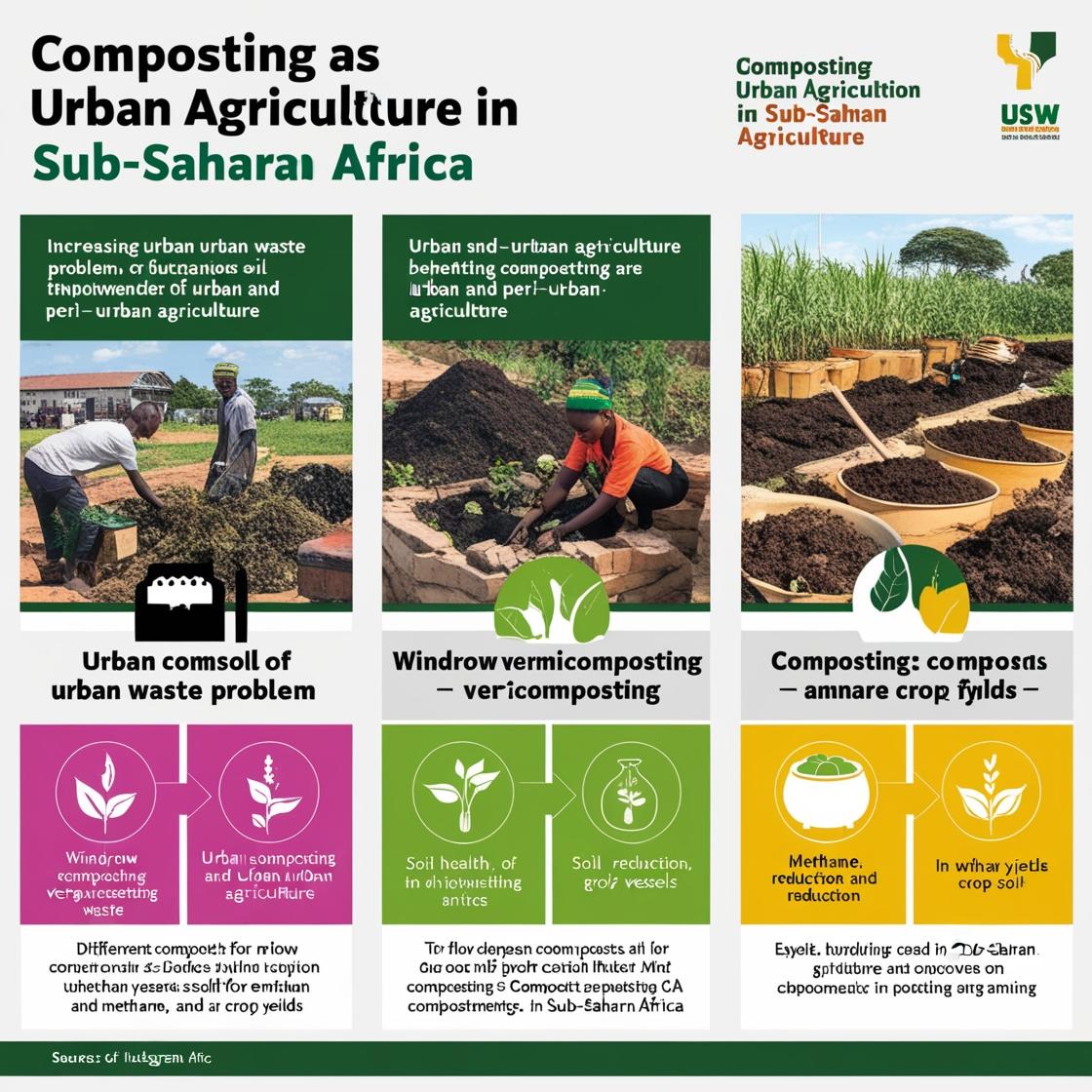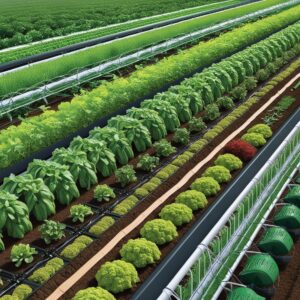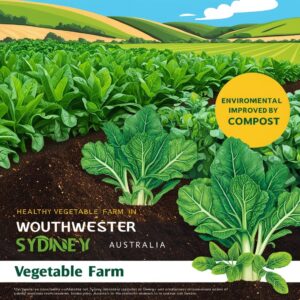Introduction
Urban and peri-urban agriculture (UPA) has gained importance across Sub-Saharan Africa as more people move to cities, intensifying the demand for local food and waste management solutions. Composting presents a valuable approach for recycling organic waste and supporting sustainable agriculture in urban areas, especially as the challenges of municipal solid waste (MSW) and food insecurity increase with rapid urbanization. This article explores how composting can play a pivotal role in sustainable UPA, addressing both environmental and food security needs in Sub-Saharan Africa.
Understanding Urban Agriculture and Its Significance
Urban and peri-urban agriculture involves growing crops and raising livestock within city limits or in nearby areas. This practice provides food, supports local economies, and addresses some of the social and environmental challenges brought about by urbanization.
Key Benefits of UPA:
- Food Security: UPA helps to meet the rising food demand of city dwellers, often supplying 5-36% of urban food needs and 90% of perishable produce.
- Economic Opportunity: This type of agriculture generates income, particularly for low-income residents, making it a tool for poverty reduction.
- Environmental Sustainability: UPA offers a natural way to recycle organic waste through composting, helping maintain healthy soils while reducing landfill use.
Challenges Facing Urban Agriculture
Despite its benefits, UPA also presents certain challenges. Close proximity to populated areas increases the risk of contamination in crops from pollutants, pathogens, and heavy metals. Land tenure insecurity and inadequate urban planning policies further complicate the expansion of UPA in cities.
The Role of Composting in Sustainable UPA
Composting MSW is not only environmentally friendly but also economically advantageous, transforming waste into valuable organic fertilizer. Here’s how composting contributes to sustainable UPA in urban African contexts:
- Soil Enrichment: Compost improves soil health, adding nutrients and improving soil structure, which is essential for high-yield urban farming.
- Reduction of Greenhouse Gases: Composting organic waste reduces methane emissions that would otherwise result from landfill disposal.
- Enhanced Crop Yield: The use of compost over chemical fertilizers can lead to healthier crops, lower food production costs, and reduce the pollution associated with chemical runoffs.
Key Techniques in Composting
Composting varies from basic to more advanced techniques, each serving different levels of urban agriculture. Here are a few effective methods:
- Windrow Composting: Organic waste is arranged in long piles and turned periodically. This method requires space but can handle large amounts of MSW.
- Vermicomposting: Using worms to break down organic material is ideal for small-scale operations and creates nutrient-rich compost suitable for urban gardening.
- In-Vessel Composting: For urban areas with limited space, in-vessel composting contains and speeds up the composting process, suitable for densely populated regions.
Practical Tips for Urban Farmers in Sub-Saharan Africa
- Select the Right Composting Method: Choose a composting technique based on the available space, climate, and scale of the agricultural activity.
- Ensure Proper Waste Segregation: Separate organic from inorganic waste to streamline composting and reduce contamination.
- Monitor Compost Quality: Regularly check moisture, temperature, and pH levels to produce high-quality compost that enriches soil without introducing harmful pathogens.
- Engage Local Authorities: Work with municipal waste management services to source organic waste, creating a symbiotic relationship between waste management and urban farming.
Conclusion: Key Takeaways
Incorporating composting into urban and peri-urban agriculture can help sub-Saharan Africa tackle issues like waste management, food security, and environmental sustainability. By adopting composting practices, urban farmers can benefit from higher yields, healthier soils, and a cleaner environment.
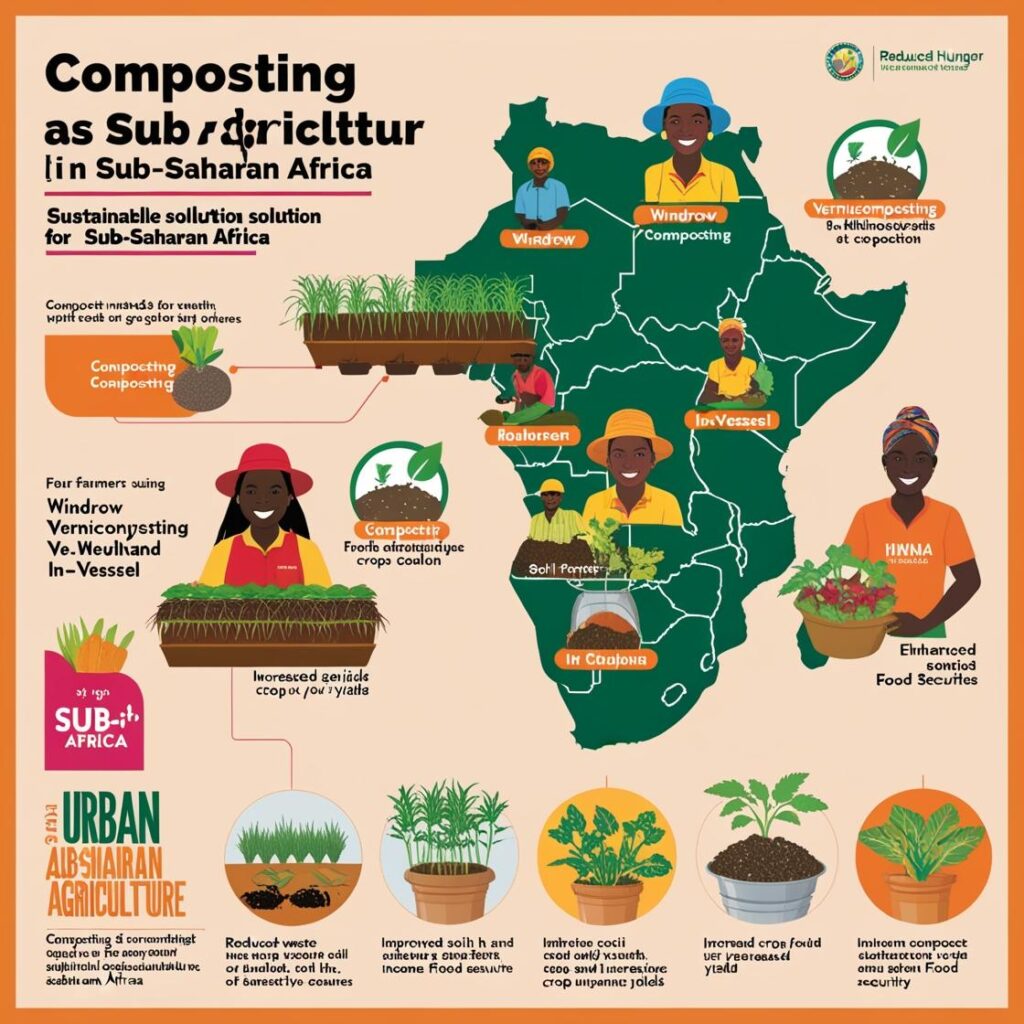
Summary for Instagram Reels and Infographics
- Urban Growth = More Waste: Rising urbanization increases the need for sustainable waste solutions.
- UPA Benefits: Reduces hunger, generates income, promotes food security.
- Composting Methods: Windrow, Vermicomposting, and In-Vessel techniques.
- Why Compost?: Improves soil, lowers methane, boosts crop health.
- Tips for Farmers: Select the right compost method, segregate waste, monitor compost quality.
This summary serves as a visual and actionable guide for raising awareness on sustainable UPA practices across social media platforms.




Soil fertility decline is a pressing issue in Sub-Saharan Africa, where food production per capita has not kept pace with population growth. The degradation of soil, attributed to factors like nutrient depletion, erosion, and inadequate fallow periods, impacts food security and the sustainability of agriculture in both rural and urban areas. Soil erosion not only depletes land of essential nutrients but also affects water quality in rivers and lakes, leading to broader environmental and health concerns for both humans and animals.
To address this, sustainable soil management practices are essential. One approach, Integrated Soil Fertility Management (ISFM), promotes a mix of organic and inorganic inputs, soil and water conservation techniques, and biological interventions. ISFM’s holistic perspective integrates agronomy, ecology, and economics, encouraging sustainable agricultural practices that improve food security while minimizing environmental degradation.
Urban agriculture, specifically, can play a role in nutrient recycling through composting of municipal solid waste (MSW), which is high in organic matter. Sub-Saharan cities produce large amounts of MSW with up to 75% organic content, presenting a significant opportunity for composting to replace mineral fertilizers with organic compost. Composting not only reduces greenhouse gas emissions—methane from landfills has a 21-fold greater global warming potential than carbon dioxide from composted waste—but also addresses urban waste management challenges.
However, composting initiatives face operational hurdles, such as the need for infrastructure, community involvement, and supportive policies for integrated waste management. In the face of increasing urbanization, Sub-Saharan cities must adopt sustainable waste management policies that support urban agriculture, enhance soil fertility, and promote ecological stability across urban and peri-urban environments.
The composting of municipal solid waste (MSW) is a biological process managed to optimize microbial activity for breaking down organic material in waste. Composting is driven by the action of bacteria and fungi in biofilms on organic particles, requiring specific conditions such as appropriate temperature, moisture, oxygen, and carbon-to-nitrogen (C) ratios for the optimal degradation process.
Stages of Composting
- First Mesophilic Phase: The initial phase (10–42 °C) lasts a few hours to days, marked by mesophilic bacteria and fungi breaking down simple organic materials, raising temperatures to about 45°C.
- Thermophilic Phase: In this phase, lasting from days to months, thermophilic bacteria, actinomycetes, and fungi decompose more complex materials like lignocelluloses. The high temperature (45–80°C) also eliminates pathogens.
- Second Mesophilic Phase: This stable phase sees recolonization by mesophilic microbes with balanced heat production and dissipation.
- Maturation and Stabilization Phase: Lasting weeks to months, this final phase involves a gradual temperature decline as remaining resistant compounds form stable humic substances.
Microbial Diversity and Benefits
A range of bacterial (e.g., Bacillus, Lactobacillus, and Actinobacteria) and fungal (e.g., Mucorales, Pezizomycotina) species are involved, and composting benefits from a mixed microbial community for efficient decomposition. Finished compost is pathogen-free and acts as a biofertilizer, boosting soil fertility, structure, and water retention.
Advantages of Composting
- Economic: Low-cost setup, income from reduced methane emissions, and alternative to agrochemicals.
- Environmental: Reduction in landfill waste, fewer greenhouse gas emissions, and recycling of organic materials.
- Social: Employment creation, biofertilizer access for farmers, and heightened community awareness of waste value.
Challenges in Developing Countries
Cost remains a key challenge compared to inexpensive landfilling, and markets for compost are limited, often necessitating subsidies or support. Furthermore, land tenure issues complicate community composting efforts, and lack of waste separation increases the risk of contamination. Improved waste policies are needed to standardize compost quality and segregate waste at the source, enhancing the sustainability of MSW composting programs.
Integrating composting into municipal waste management and supporting decentralized, small-scale composting sites near farmers could help optimize compost use, reduce transportation costs, and support urban agriculture, contributing to a sustainable food system in Sub-Saharan Africa
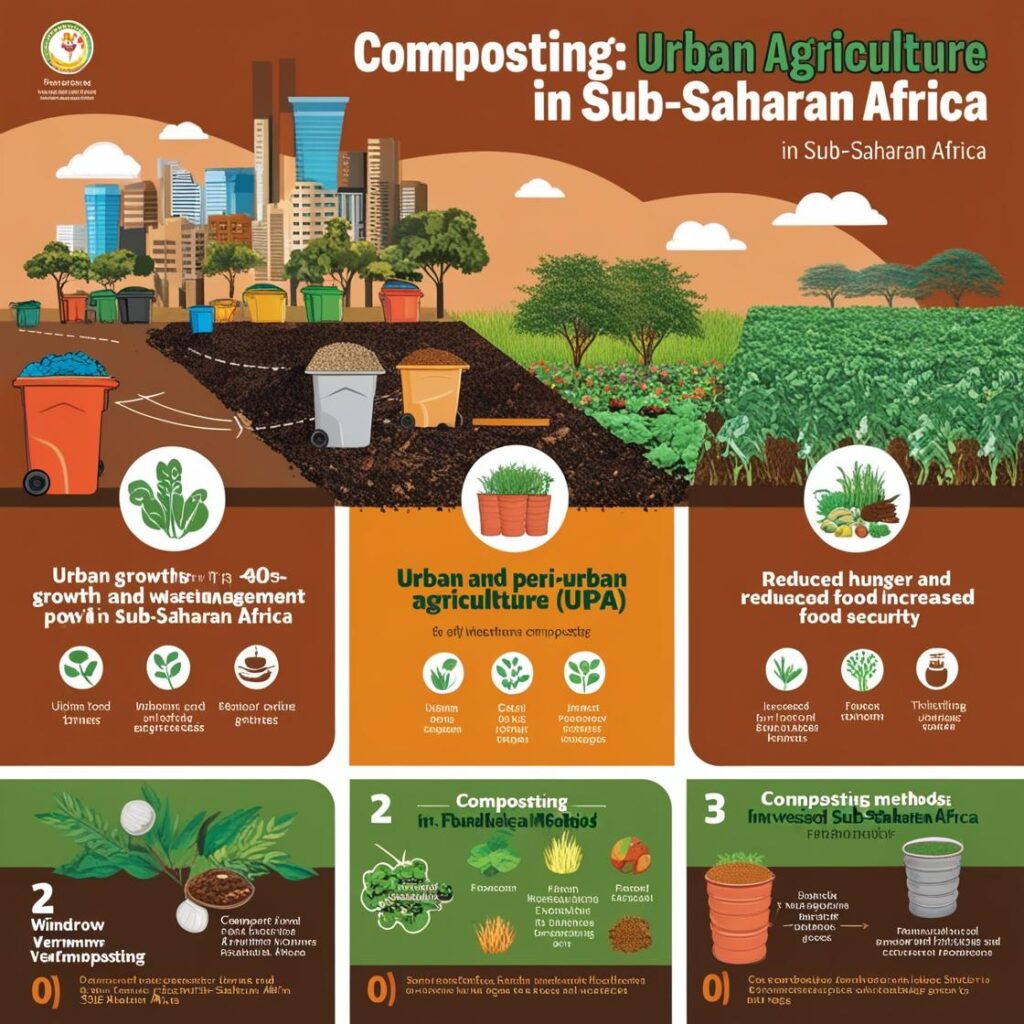
Summary of Integrated Pest Management (IPM) in Landscaping
IPM Overview: Integrated Pest Management (IPM) is a holistic approach aimed at reducing pests through environmentally sensitive practices. Unlike traditional pest control, which often involves routine pesticide applications, IPM uses a variety of methods to manage pests in ways that reduce harm to humans, wildlife, and the ecosystem.
Core Objectives:
- Understand the concept of IPM.
- Learn methods included in IPM, such as biological, cultural, mechanical, and genetic controls.
- Comprehend the importance of pest monitoring and identify injury levels.
- Recognize pest life cycles, which are critical for timing interventions.
- Utilize less harmful alternatives to chemical pesticides.
- Apply degree days and action thresholds for pest control.
IPM Strategies:
- Avoidance: Uses cultural, mechanical, and genetic strategies to prevent pest issues. This involves planting suitable species, proper site preparation, and sanitation practices.
- Treatment: If pest populations exceed thresholds, targeted treatments are applied. IPM emphasizes minimal use of chemicals, selecting non-persistent, low-toxicity options and integrating biological control agents like beneficial insects.
IPM Methods:
- Biological Control: Using natural predators, parasites, or pathogens to control pest populations.
- Chemical Control: Emphasizing the least toxic and non-persistent options, including Insect Growth Regulators (IGRs).
- Cultural Control: Ensuring optimal plant placement, pruning, watering, and sanitation to maintain healthy plants.
- Mechanical Control: Includes physical interventions like pruning, mowing, and manual pest removal.
- Genetic Control: Using pest-resistant plant varieties or cultivars suited to the local environment.
Thresholds and Monitoring:
- Thresholds: Decision points for action, such as aesthetic or economic injury levels, define when intervention is necessary to prevent unacceptable damage.
- Pest Monitoring: Regular observation and recording are essential for early detection. Tools like sticky traps and degree-day calculations aid in predicting pest emergence based on environmental conditions.
Case Study Findings: An IPM program reduced pesticide usage by over 85% in a commercial landscape setting, proving to be cost-effective by the second year. Benefits included increased beneficial insect populations and reduced chemical input, demonstrating IPM’s potential for long-term sustainability in landscape management.
Plant Selection Guidelines:
- Select pest-resistant and site-appropriate plants to minimize pest susceptibility.
- Examples of resistant cultivars include certain varieties of crabapple and lilac that are less prone to diseases like powdery mildew and fire blight.
Conclusion: IPM is a sustainable approach that balances pest control with environmental protection. By implementing IPM, landscape managers can achieve healthier landscapes with reduced dependency on chemical pesticides, preserving ecosystem health and biodiversity.
This passage delves into pest management in sustainable landscaping, emphasizing monitoring, record-keeping, and identifying pest and beneficial species. Here’s a summary of the key elements:
Integrated Pest Management (IPM) Approaches:
- Record-Keeping and Monitoring: Helps diagnose problems by analyzing changes in plant species, neighboring activity, and historical events.
- Identifying Pests and Damage Sources: Specific pests and diseases affect particular plant species. Proper identification helps in attributing damage correctly.
- Observation and Traps:
- Sticky Traps: Effective for pests like aphids and thrips. Color attracts certain insects (yellow for general, blue for thrips, purple for emerald ash borers).
- Pheromone Traps: Use chemical signals for pest detection; sensitive to specific species and can attract low-density pests.
- Branch Beating: Dislodges pests from branches onto a surface, making them easier to count.
- Phenology and Degree Days: Studies the impact of temperature on pest development, using “degree days” to time pest management activities effectively.
- Degree Days Calculation: Involves max and min daily temperatures, with a baseline threshold for insect development (usually 50°F/10°C).
- Timing for Control: Pest activity phases and control windows are often correlated with specific degree day ranges and phenological cues like bloom times of indicator plants.
This methodical monitoring, aided by traps, record-keeping, and degree day data, allows for better-timed and effective pest control within sustainable landscaping practices.
Key Concepts:
- Action Thresholds:
- Purpose: To identify when pest control action is necessary to avoid undesirable effects, such as economic or aesthetic loss.
- Commercial Crops: Economic thresholds compare the cost of pesticide application to the cost of crop loss, taking action only when losses surpass treatment costs.
- Landscaping and Aesthetic Injury Level (AIL): For ornamental plants, aesthetic factors often determine action. The AIL is the lowest pest population level causing visible injury, guiding decisions about pesticide use.
- Alternative Pest Controls:
- Biological Controls: Involve natural predators, parasites, and pathogens that attack pests. Examples include ladybugs (predators of aphids) and Bacillus thuringiensis (a bacterium toxic to caterpillars).
- Botanicals: Derived from plants and provide natural pesticide options.
- Non-Toxics and Insect Growth Regulators: Non-toxic substances target pests without harmful residues, while insect growth regulators disrupt pest life cycles without direct killing.
- Biological Control Examples:
- Predators: Includes species like lady beetles, lacewings, and mantises that target aphids, mites, and other pests.
- Parasitoids: Specific wasps (e.g., Encarsia formosa) are introduced to control pests like whiteflies by parasitizing them.
These concepts emphasize reducing pesticide reliance by using pest-specific action thresholds and incorporating alternative controls that minimize environmental impact.
Key Points:
IPM is designed to control pests using environmentally friendly strategies, balancing prevention with targeted treatment. The use of botanicals, biological controls, and pest-resistant plants minimizes reliance on synthetic pesticides while supporting ecosystem health.
Action Thresholds and Aesthetic vs. Economic Considerations:
Action thresholds help determine when pest control is needed, aiming to avoid significant economic or aesthetic damage.
Economic thresholds are used in agriculture to decide on pesticide application based on the costs of crop loss vs. treatment.
Aesthetic thresholds apply to landscapes where appearance is a higher priority than economic impact.
Alternative Pest Controls:
Botanical Pesticides: Derived from plants, these include various oils and extracts (like canola, castor oil, citronella, and pyrethrins) targeting a range of pests. Each has specific uses, from repelling animals to killing insects.
Insect Growth Regulators (IGRs): Synthetic or naturally occurring chemicals that disrupt insect development. Examples like kinoprene target soft-bodied insects, while others like diflubenzuron inhibit exoskeleton formation.
Prevention and Treatment in IPM:
Prevention: Involves proper plant selection, genetic pest resistance, and effective cultural practices.
Treatment: Uses action thresholds, regular monitoring, and a preference for less toxic, less persistent pesticides and biological controls.
Monitoring Techniques: Scouting, traps, and degree days (temperature accumulations over time) help accurately time pest emergence and treatment.
Degree Days and Phenological Indicators:
Degree days help predict pest cycles more accurately than calendar dates. This timing, along with indicators like bloom times, aids in identifying peak pest emergence periods, allowing for precise management.
Summary of IPM Goals:
IPM is designed to control pests using environmentally friendly strategies, balancing prevention with targeted treatment. The use of botanicals, biological controls, and pest-resistant plants minimizes reliance on synthetic pesticides while supporting ecosystem health.
What is integrated pest management?
Integrated pest management (IPM) is a comprehensive strategy for managing plant pests that combines multiple methods to minimize environmental impact, human risk, and harm to beneficial organisms. IPM focuses on prevention and treatment through monitoring, action thresholds, and environmentally friendly controls.
What role do plant breeding programs play in integrated pest management?
Plant breeding programs are essential for IPM as they develop pest-resistant plant cultivars, which serve as a primary defense against pest infestation. Using genetically improved, pest-resistant varieties reduces the need for chemical treatments and helps maintain ecosystem balance.
What are five major components of a successful pest control strategy?
The five major components of a successful pest control strategy are:
- Prevention through plant selection and cultural practices
- Monitoring and scouting for early pest detection
- Setting action thresholds to determine when intervention is necessary
- Employing alternative pest controls, such as biological and botanical methods
- Using targeted, less-toxic treatments only when necessary
What is phenology?
Phenology is the study of the timing of natural events in plants and animals, such as flowering or pest emergence, in response to seasonal climate changes.
What are degree days and how are they used?
Degree days are a measure of accumulated heat over time, used to predict the life stages and emergence of pests. This information helps determine the optimal timing for pest management interventions.
What is the purpose of an action threshold?
An action threshold is the pest population level at which control measures should be applied to prevent unacceptable damage or economic/aesthetic loss.
What is an AIL and how is it used?
An Aesthetic Injury Level (AIL) is the lowest pest population level that causes visible or aesthetic damage to ornamental plants. It is used to decide when to take action in non-economic settings, focusing on maintaining appearance rather than preventing financial loss.
Name three types of alternative pest controls. What are the two primary botanical pesticides used in landscape pest management?
Three types of alternative pest controls are:
- Biological controls (e.g., predators and parasites of pests)
- Botanical pesticides (plant-derived chemicals like pyrethrins and neem)
- Insect growth regulators (chemicals that disrupt pest life cycles)
The two primary botanical pesticides used in landscape pest management are pyrethrins and neem.
What are two advantages of managing pests using insect growth hormones?
Two advantages of using insect growth hormones are:
They disrupt the pest’s life cycle in precise ways, often without leaving harmful residues or impacting the environment as strongly as conventional pesticides.
They are highly selective, targeting specific pests without harming beneficial organisms.

About Us
Welcome to Agriculture Novel, your go-to source for in-depth information and insights into the world of agriculture, hydroponics, and sustainable farming. Our mission is to educate, inspire, and empower a new generation of farmers, hobbyists, and eco-conscious enthusiasts. Whether you’re interested in traditional farming practices or modern innovations, we aim to provide comprehensive guides, expert tips, and the latest updates in agriculture and urban farming.
At Agriculture Novel, we believe in the power of knowledge to transform the way we grow, sustain, and nourish our world. Explore our articles on topics like Fruit Growing Guide, Hydroponics, Plant Deficiency Guide, and more.
Thank you for joining us on this journey towards a greener, more sustainable future!
About Agronique Horizon
At Agronique Horizon, we specialize in delivering comprehensive digital marketing and web development solutions tailored for the agriculture and hydroponics industries. From custom website design and app development to social media management, we provide end-to-end support for brands aiming to make a meaningful impact. Our team also offers innovative solutions for the real estate sector, bringing precision and visibility to your projects. Learn more about our services here and discover how we can elevate your digital presence.

